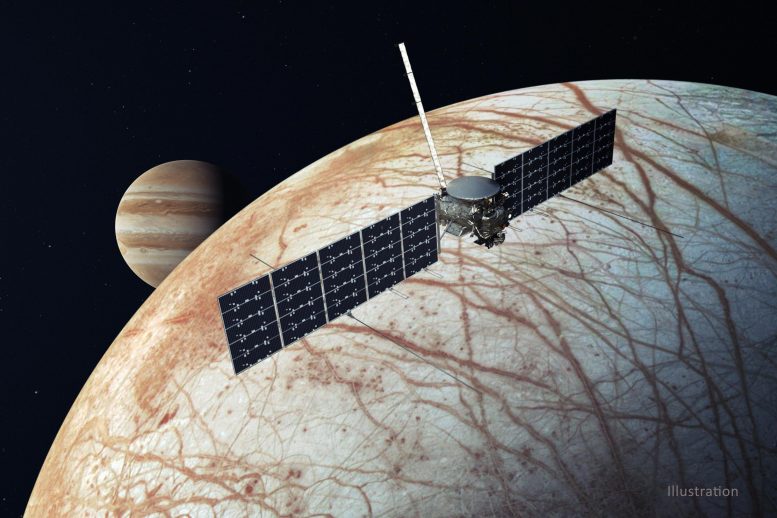
NASA’s Europa Clipper mission is focused on solving transistor radiation issues as it prepares for launch on an expedition to Jupiter to explore Europa’s habitability.
The mission faces challenges with radiation-resistant transistors, discovered to be less durable against Jupiter’s intense radiation. Tests at various NASA centers aim to address these issues.
Preparations for the launch of NASA’s Europa Clipper mission are progressing. The spacecraft was delivered to the Kennedy Space Center in Florida this past May, and the team has successfully installed the high-gain antenna.
Engineers with NASA’s Europa Clipper mission continue to conduct extensive testing of transistors that help control the flow of electricity on the spacecraft. The particular versions used by Europa Clipper are radiation-hardened and are intended to tolerate 100 to 300 kilorad, or krad (a “rad” is a unit of measure for absorbed dose of ionizing radiation).
However, the mission team at NASA’s Jet Propulsion Laboratory (JPL) in Southern California, which manages the mission, is assessing test data that indicates some transistors could be affected by significantly lower radiation levels in some conditions. They are concerned that some of these parts may not withstand the radiation of the Jupiter system, which is the most intense radiation environment in the solar system.
Radiation Challenges and Ongoing Analysis
Tests also are being conducted at the Johns Hopkins Applied Physics Laboratory (APL) in Laurel, Maryland, and NASA’s Goddard Space Flight Center in Greenbelt, Maryland. APL designed the main spacecraft body in collaboration with JPL and NASA Goddard.
The issue with the transistors came to light in May when the mission team was advised that similar parts were failing at lower radiation doses than expected. In June 2024, an industry alert was sent out to notify users of this issue. The manufacturer is working with the mission team to support ongoing radiation test and analysis efforts in order to better understand the risk of using these parts on the Europa Clipper spacecraft.
Electronics Durability and Solutions
Testing data obtained so far indicates some transistors are likely to fail in the high-radiation environment near Jupiter and its moon Europa because the parts are not as radiation resistant as expected. The team is working to determine how many transistors may be susceptible and how they will perform in-flight. NASA is evaluating options for maximizing the transistors’ longevity in the Jupiter system. A preliminary analysis is expected to be complete in late July.
Radiation-hardened electronics are used throughout industry to protect spacecraft from radiation damage that can occur in space. The Jupiter system is particularly harmful to spacecraft as its enormous magnetic field — 20,000 times stronger than Earth’s magnetic field — traps charged particles and accelerates them to very high energies, creating intense radiation that bombards Europa and other inner moons. It appears that the issue that may be impacting the transistors on Europa Clipper is a phenomenon that the industry wasn’t aware of and represents a newly identified gap in the industry standard radiation qualification of transistor wafer lots.
Mission Objectives and Future Prospects
Europa Clipper’s launch period opens on October 10, and it is set to arrive at Jupiter in 2030, where it will conduct science investigations to understand the potential habitability of Europa as it flies by the moon multiple times.
The overall cost of the Europa Clipper mission is estimated to be around $5 billion, making it one of the more expensive planetary science missions. This budget covers the development, launch, and operations of the spacecraft over its planned mission duration.
Europa Overview
Europa, one of Jupiter’s largest moons, is especially notable for its potential to harbor life. Covered by a thick crust of ice, Europa is believed to contain a vast subsurface ocean of salty water beneath its icy exterior, kept warm by tidal heating from Jupiter’s gravitational pull. This internal heating causes the ice to shift and crack, leading to a surface marked by ridges, bands, and a relatively young and smooth terrain, devoid of large impact craters. The intriguing possibility that this hidden ocean might support microbial life, along with the presence of a tenuous atmosphere primarily composed of oxygen, makes Europa a prime target for future astrobiological missions. These missions aim to explore its ocean’s potential habitability and the broader mysteries of this icy world.
1 Comment
Those $5 billion are not “on the line”. They’re already wasted, because everything you put up in space is a future space junk.